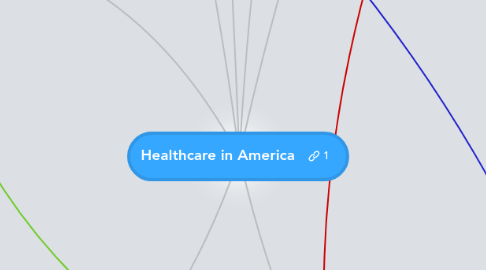
1. Health of Americans
1.1. Trends over past 50 years
1.1.1. Good
1.1.1.1. The death rate has gone down
1.1.1.2. Primary Prevention
1.1.1.2.1. More emphasize has been place on a healthier lifestyle
1.1.1.3. Secondary Prevention
1.1.1.3.1. Identify and lower cholesterol rates
1.1.1.4. Smoking rates have gone down
1.1.1.4.1. 46.5 million adults still smoke
1.1.1.5. Infant mortality rate is down
1.1.2. Bad
1.1.2.1. Prevalence of Illnes has gone up
1.1.2.2. Obesity has gone up
1.1.2.2.1. At record high
1.1.2.2.2. Diabetes rates have risen by 70% in last 10 years
1.1.2.3. Intake of saturated fat has gone up
1.1.2.4. Chronic Illness of the elderly has gone up
1.1.2.5. 60% of Adults do not exercise enough
1.1.2.5.1. 25% get no exercise
2. Outpatient Care
2.1. Description
2.1.1. No overnight stay
2.1.2. Diagnostic or therapeutic care provided in a "walk-in" setting
2.1.3. Easily accessible to patient
2.1.4. No fee for time stayed
2.2. Types
2.2.1. Primary
2.2.1.1. Lowest duration, frequency & level of intensity
2.2.1.2. focused on prevention, health promotion & early detection of illness, injury or impairment
2.2.2. Secondary
2.2.2.1. Short-term
2.2.2.2. Consultation from a expert opinion for specific need
2.2.2.3. ex. surgery, dialysis, women's, eyes
2.2.3. Tertiary
2.2.3.1. Institution based
2.2.3.2. Highly specialized and tech driven.
2.2.3.3. ex. trauma, burn, neonatal, transplant
2.3. Settings
2.3.1. Private Practice
2.3.2. Hospital
2.3.3. Free-standing
2.3.3.1. ambulatory surgery centers
2.3.4. Mobile
2.3.4.1. MRI truck
2.3.5. Home health
2.3.5.1. delivered
2.3.6. Telephone
2.3.7. Alternative/non-traditional
2.3.7.1. any of the above
2.3.7.2. shopping malls
2.3.7.3. other
2.4. Overview
2.4.1. If outpatient care was perfectly accessible to all, other care would be limited to emergency and inherited conditions
2.4.2. Primary Care should be first and only source
2.4.2.1. Point of entry to all other care settings
2.4.2.1.1. Gatekeeper: making sure patient gets what and goes exactly where they should
2.4.2.2. Coordination of care
2.4.2.2.1. making sure patient gets all the services needed from someone seeing the whole picture
2.4.2.3. Essential care
2.4.2.3.1. Having a relationship with provider helps for better future planning and thinking
3. Insurance
3.1. Low Income - Medicad
3.1.1. Does not cover all medical services and needs
3.2. Elderly - Medicare
3.2.1. Does not cover all medical services and needs
3.3. Supplied through Employeers
3.3.1. Big Business
3.3.1.1. Huge Discounts
3.3.1.1.1. More employees at an organization, the bigger the discount
3.3.2. Small Business
3.3.2.1. Expensive
3.3.3. Self-Employeed
3.3.3.1. Very expensive
4. New node
5. No insurance
5.1. Emergency rooms have to except you
5.2. No prescriptions
5.3. HUGE DEBT
5.4. No Primary care
5.5. No Secondary care
6. Inpatient Facilities and Services/Hospitals
6.1. Description
6.1.1. Inpatient usually means overnight stary
6.1.1.1. can be less than 24 hours
6.1.1.2. might not include nighttime hours
6.1.2. Now includes outpatient & non-acute services, but primarily inpatient
6.1.3. At least 6 beds
6.1.4. licensed by state of location
6.1.5. Organized staff of doctors
6.1.6. Continuous nursing services under supervision of RN
6.1.7. Financial fees included board, ALWAYS!
6.2. Classification
6.2.1. Ownership
6.2.1.1. Private
6.2.1.1.1. Non-profit
6.2.1.1.2. Profit
6.2.1.2. Government/Public
6.2.1.2.1. State
6.2.1.2.2. Local
6.2.1.2.3. Federal
6.2.2. Length of Stay
6.2.2.1. Short
6.2.2.1.1. Less than 25 days
6.2.2.2. Long
6.2.2.2.1. Greater than 25 days
6.2.3. Type of Service
6.2.3.1. General
6.2.3.1.1. Variety of services
6.2.3.2. Specialty
6.2.3.2.1. Specific types of diseases or medical conditions
6.2.3.3. Psychiatric
6.2.3.3.1. psychiatric-related illnesses
6.2.3.4. Rehabilitation
6.2.3.4.1. therapeutic services to restore the maximum level of functioning in patients who have suffered disability due to illness or accident
6.2.3.5. Children’s hospitals
6.2.3.5.1. Dealing with complex, serve or chronic illnesses among children
6.2.4. Other
6.2.4.1. Teaching
6.2.4.1.1. one or more graduate programs
6.2.4.1.2. w/ medical school
6.2.4.2. Church
6.2.4.3. Osteopathic
6.2.4.3.1. allopathic medicine
6.2.4.4. critical access
6.2.4.4.1. rural area
6.2.4.4.2. under 25 beds
6.2.4.4.3. limited services
6.3. Relation to Healthy Population
6.3.1. wellness programs
6.3.2. Safety fairs
6.3.3. secondary prevention
6.3.4. professional staff
7. Long-term /Nursing Homes
7.1. Description
7.1.1. Chronic conditions
7.1.2. designed around individual to promote independence
7.1.3. total care
7.2. Characteristics
7.2.1. Holistic
7.2.2. Considerate of preferred life
7.2.2.1. activites
7.2.2.2. environment
7.2.2.3. comfort
7.2.2.4. relationships
7.2.2.5. compassion
7.2.2.6. respect
7.2.2.7. personal choice
7.3. Services
7.3.1. Medical
7.3.2. Mental Health
7.3.3. social support
7.3.4. preventive and therapeutic
7.3.5. informal
7.3.6. community based
7.3.7. intensity levels
7.3.7.1. personal
7.3.7.2. custodial
7.3.7.3. restorative
7.3.7.4. skilled nursing care
7.3.7.5. subacute care
7.3.8. Housing
7.3.9. End of Life
7.4. Related to Healthy Population
7.4.1. Chronic illness in the elderly
7.4.2. Special needs
7.4.3. young adults
7.4.3.1. permanent disability
7.4.4. HIV/AIDS
7.4.5. Other
7.4.5.1. Alzheimers
7.4.5.2. head trauma
7.4.5.3. comatose
